Cartomancy Anthology contains so many games!
22 cards for 22 games. Cartomancy Anthology certainly provides more than a booster pack’s worth of content.
Although uncommon, anthology games are an interesting species. Containing multiple games based on a common theme from a number of different developers, they have a variety of different interpretations of that theme shown in wildly different ways. The best example of this is the Dread X Collection and its follow ups, with their explorations of different horror themes. Cartomancy Anthology follows a similar path, focusing on tarot cards. Now, I know little to nothing about tarot, but each game here is themed around the name of each card in a deck. This is a nice approach and gives developers some scope to be quite creative.
Equally creative is how you select a game to play. Essentially, you take a tarot reading, being assigned three random cards, and playing the games attached to them. You can set this to only give you cards/games you haven’t experienced before too, so there’s no risk of playing something you’ve already experienced if you don’t want to. There’s the option to go back and replay games of your choice too, so you don’t always have to leave everything to fate.
There are 22 games here, so I’ve decided the best approach is to quickly review each game in the order I received them. Some were significantly longer than others, but they all have something to offer.
The Magician – The Magician
The first game I played was quite an esoteric one. In this five minute narrative game, you return home from a journey and carry out a rite to reminisce on your experiences. You add glass pebbles to a scrying bowl and recount your journey and how you feel on your return. Various artefacts that you brought with you appear damaged or not behaving in the way you expect. Before long, the tale is over and you’re returned to the menu.

Mechanically, there’s little to do here other than move pebbles into water, but there’s a sweet story about being happy for things that have happened rather than sad over the loss of them to the past. There’s some nice art and music here too, but The Magician wasn’t the best first impression for Cartomancy Anthology. I was hoping for something a touch more interactive.
The Chariot – Ritual Roadtrip
Offering more interaction, we have Ritual Roadtrip, in which you transport two ritualists to prevent a storm from reaching and potentially destroying civilisation. The two you’re delivering have different approaches to the ritual, and ask that you control the chariot to collect the items they need. One is interested in crystals and earth, whilst the other demands animal carcasses. Along the way, they’ll banter with each other and ask your opinion before you reach the storm.
You receive a marginally different ending, although none of them are terribly definitive, depending on if you favour one, the other, or keep things balanced. The lack of a really solid ending hammers home the point here is the journey over the destination. Whilst I like that there’s more engagement here, the path is completely linear, and you can only move slightly left and right to collect items. There’s little player feedback too, making it tricky to tell how far ahead one ritualist is compared to the other. I did like the storm looking more threatening as it looms ever closer, and the rest of the presentation was solid enough. Not bad, but I feel there could be stronger offerings around the corner.
The High Priestess – The Seer & The High Priestess
Easily my favourite of the initial offerings, The Seer & The High Priestess has you play the titular seer, who is due to replace the high priestess of a village, in spite of their uncertainty over their capability. Their duties are to help the villagers with difficult problems by consulting their cards, and as a final test, your seer is sent out to resolve issues themself. You’ll move around a very nicely presented 3D world that is the village, and speak to the locals. They confide in you before you consult your cards to help them reach a resolution.

And this is where the game really stands out. For each problem, you have a grid with a selection of white and black dots, and you need to turn a certain number of them black using your cards. Each card has a shape made of dots, and when playing a card, any dot on the grid that is lined up with the card will change colour. You’ll need to use them carefully to change the requisite number of dots, and in many cases there are several solutions depending on how you play your cards. I really enjoyed this, and felt like these puzzles could be fleshed out to a game in their own right. As it stands, this half hour experience is really solid, with a nice tale of finding ways to help yourself, as well as coming to terms with your strengths and weaknesses.
Judgement – Seeds of Judgement
Another strong offering, but this time in the mould of a visual novel crossed with a farming sim. You have died and are awakened in a garden by a mysterious crow, but you appear to be a scarecrow. The crow tells you that to learn more about your life and to move on, you must judge the souls of the dead as they reach the garden and determine who is admitted, before tending to them as crops so they can move on for themselves. Each season will start with a number of souls arriving, appearing as fruits and vegetables which is a really quite sweet way of presenting them, each with a short list of traits from their life.
You can talk to them before passing judgement to learn more about them if you’d like. Some of them are well written, with interesting stories to tell depending on the dialogue choices you make, whilst others are a bit all over the place with responses that don’t make sense based on your choice, text that’s chopped off at the end, or occasional absolute repeats of characters. I enjoyed this one in spite of these issues though. Once you’ve made judgements, you tend to those that remain in the garden by watering them and speaking to them before moving on to the next season. This felt a little perfunctory, but thematically made sense. The nice art and music certainly helped this one feel like time well spent, but those errors could do with some ironing out.
The World – The World
The World is a visual novel of sorts, in which you play as the four aspects of a woman named Eon, each represented by a different animal. According to the tutorial, you can switch between these animals at certain points in the story to change the events that are currently unfolding. I say “according to the tutorial” because I just couldn’t get this game to work properly. I couldn’t switch characters, I couldn’t see the “wheel” that shows previous events, and the special abilities I was meant to have access to just didn’t work.
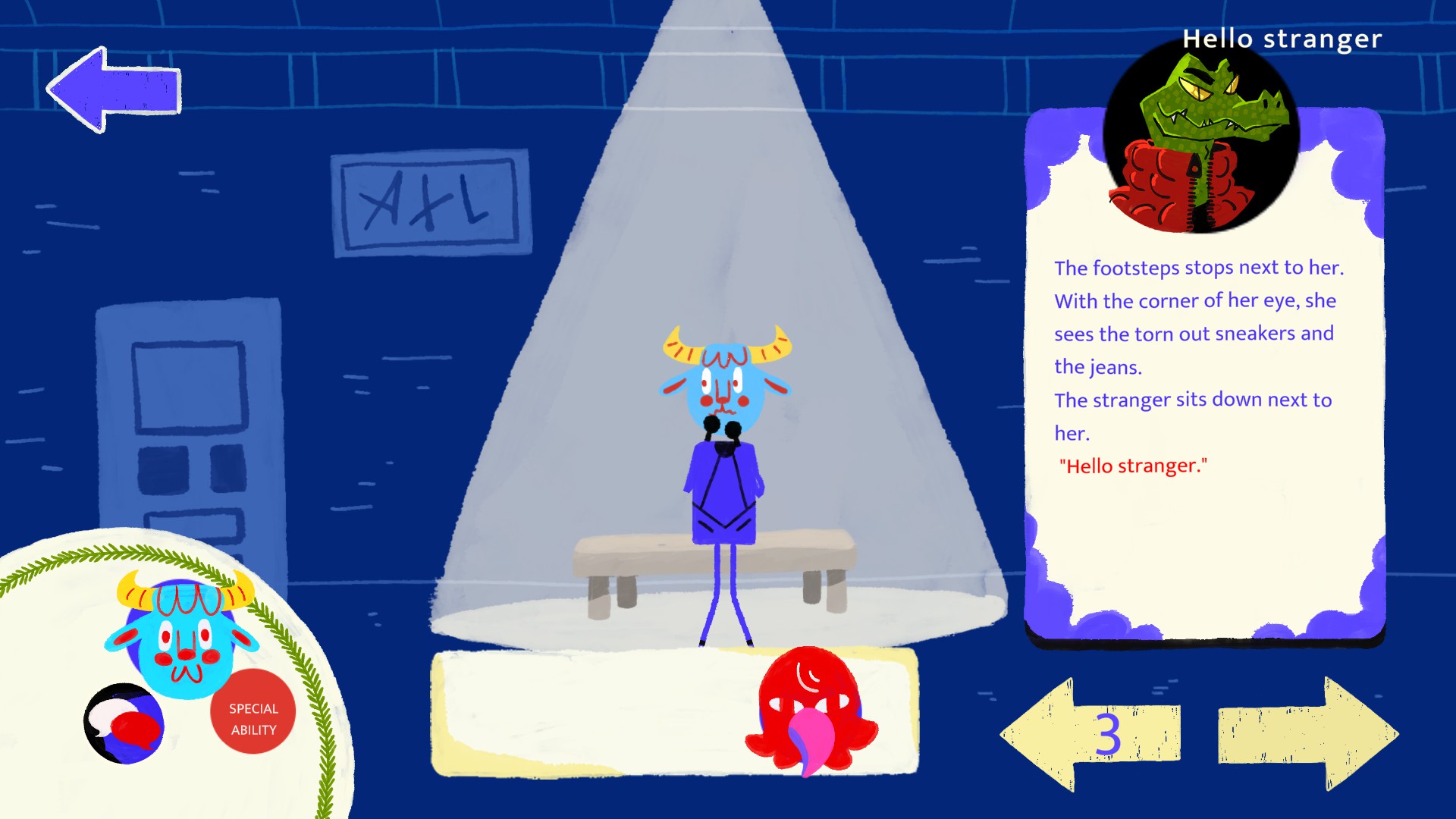
There’s no music here, but some of the sound effects are nice enough. The visuals are quite weak but do attempt to convey what’s going on, with some nice shifts in the background environments. The use of the text area was less well done though, as words would often overrun into the background making them hard to read. I had to give up on The World as I wasn’t getting anywhere. Maybe that’s the point of this one…
The Lovers – Tonight, Together
On the surface, this one is quite sweet, with you at a party to celebrate the death of the head necromancer. You’re spending time there finding someone to hang out with by walking around the party, chatting to whoever you’re allowed to. Once you find someone, there’s a little dance minigame in which you try to follow your partner’s path by using the mouse to trace the route as quickly as you can. It doesn’t seem to matter how well you do though. There’s some darker undertones here depending on the dialogue choices you make, but on the whole I liked this one.
The visuals are nice. Even though your view during the sections in which you explore the party is very small, there are visual effects around the rest of the screen that are suited to the room you’re in. Flashing lights for the dance floor, bubbles for the bar, and such. It’s a nice effect that gives the game a bit more personality. The sound is nice too, with the music shifting appropriately based on current events in the ten-minute experience. There’s a nice feature for you to create your own character with their own pronouns too. Not bad!
The Emperor – The Emperor
Another solid offering, and one I particularly liked, The Emperor tasks you with being the chef of the titular ruler, and you need to cook to his specifications lest you are executed. On each of the four days, you’ll be given a poem that you need to interpret to determine the monarch’s mealtime musings before exploring the palace to gather ingredients and inspiration. Depending on where you go, you’ll get ingredients that link to themes such as fury and joy, as well as recipes that you can then make. If you have the right ingredients, you can make a recipe that fits certain themes, and you can create up to three a day to present.
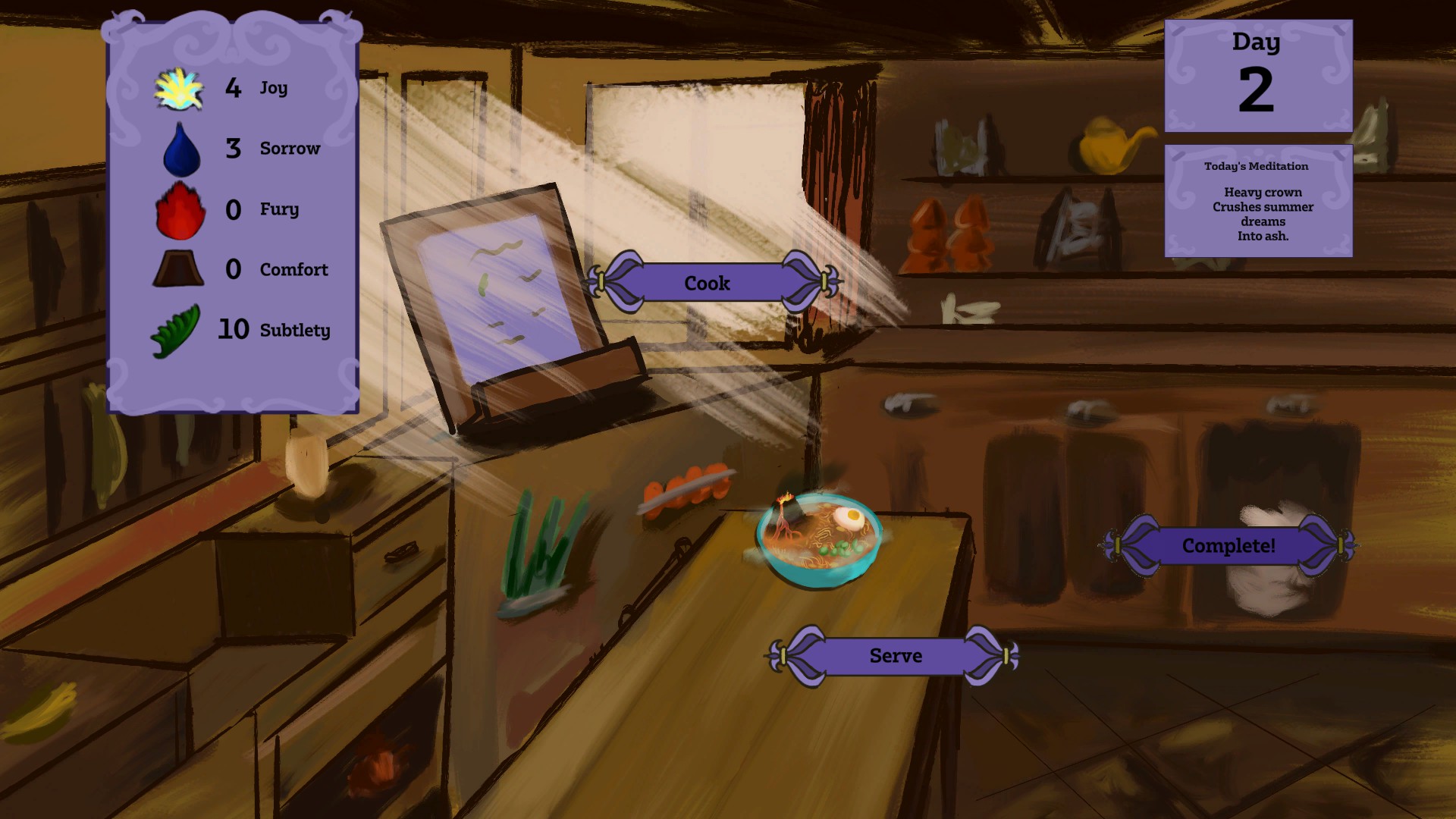
I really enjoyed this, as the poems are subtle enough to not give the game away, but not so complicated that you can’t figure out the answer. There are plenty of recipes to choose from too, meaning plenty of solutions to the poems you are presented with. Exploring the palace is a bit hit and miss, as you can’t be too sure what you’ll get based on where you travel, but you generally get enough to have a good go at cooking anyway. There’s a nice introspective ending too that has you think about who you perhaps cook for in your life. I liked this one rather a lot and wouldn’t mind it being a bit longer than the fifteen minutes it lasted.
The Star – The Star
This one was nice enough, with you controlling two halves of a whole on opposite ends of a map. You move each one right to left or left to right, needing to move between planes to make objects in the background to match for each side. This allows you to progress further to then meet in the middle. There are some nice themes here, including acceptance of yourself and others, and being willing to compromise. The real star here — pun absolutely intended — is the art style.
It’s a really interesting mashup of different styles, although it does lift some images wholesale from elsewhere which I’m not a fan of. It comes together in such an interesting, abstract way. Every scene along the path has something interesting to see, and this element alone elongated what would otherwise be a five minute experience considerably. The sound and music were somewhat perfunctory by comparison, but on the whole this is worth a go for that art style alone.
The Hierophant – The Hierophant
A very brief game, but another with a fantastic art and animation style, The Hierophant has you play as a character on their way to break up with their girlfriend. Along the way you can think back over the relationship before making a decision at the end as to whether you should stay or go. It’s nice enough, and I found the ending where they stay together quite sweet.

Honestly, there’s not a huge amount here, but that art style really is lovely and I hope to see it used again elsewhere. There’s a major lack of sound and music here though, with most of the experience playing out in silence. Regardless, I liked this one well enough.
The Moon – The Moon
Yet another solid offering in the form of The Moon. This time you play as a villager seeking to collect moonlight to return light to their now silent city. You’ll move around a gorgeous isometric voxel world, walking on land, surfing on water, and collecting orbs of moonlight. You’ll quickly earn the ability to raise and lower the water level to give you access to other areas. This creates some interesting puzzles as you find points that can lock the current water level to allow you to reach even higher or lower levels.
The puzzles were simple enough, but they felt nice to get through, and the game is over in about fifteen minutes meaning the mechanics don’t outstay their welcome. Occasionally it isn’t too clear what you’re meant to do, but a subtle path of light will show you the correct direction at least. Again, the art style helps make this an enjoyable experience, and the lovely music and solid voice acting add an extra layer that is missing from some of the other offerings in Cartomancy Anthology. Yet another winner here.
Justice – Justice
Up next we have Justice, which handles some pretty severe themes. You are an oracle who is approached by a famous man you know to be a liar. He seeks an explanation for his dreams, but your skills allow you to pick out his lies and have him confess to the sexual assault and murder of a young woman. The way this character speaks about women is the epitome of misogyny that is so often seen online these days, and reading some of the text was quite uncomfortable at times, but it’s still an important message.

Mechanically, you move a hand around a wheel to match symbols which progress the story, or move an eye over the man’s words to root out lies. It’s simple, and you mostly just follow prompts, but finding the lies feels intuitive and satisfying, even in its simplicity. The visuals are quite basic, and there was a complete lack of sound and music, which was odd considering your oracle supposedly uses music to solve people’s problems. I wouldn’t say this is the most exciting game in the package, but it’s certainly one of the more interesting ones narratively speaking.
Death – Number 13
Number 13 is a weaker effort from a gameplay standpoint. You play as a skeleton, who may or may not be Death, who rides a skeletal horse across a landscape made up of forests, jungles, and farms, amongst other places. Eventually you reach what looks like a graveyard and then the game ends. The whole thing is accomplished by pressing W, with maybe the odd push of shift if you fancy riding a bit faster.
Honestly, there’s not much to this. Perhaps there’s a deeper meaning to everything, what with the really striking art style and the fact colourful beams shoot out of your skull at the end, but Number 13 feels more like a student art project than a game. I liked the music, which was ominous and had a growing sense of threat as you travelled, but this wasn’t really a winner in my book.
The Fool – The Fool’s Fairytale
The Fool’s Fairytale is a kinetic novel in which the heir to the throne travels the land, meeting various people with the sole question “What is the purpose of a monarch?” upon their lips. This promises to be a queer reimagining of fairytale tropes, and although there are queer elements in the story, there doesn’t seem to be much in the way of a fairytale here. You move from character to character, hearing what they have to say on the subject of monarchy before returning home to the Quing and Queen — with Quing being a great word and one I want to see more of.
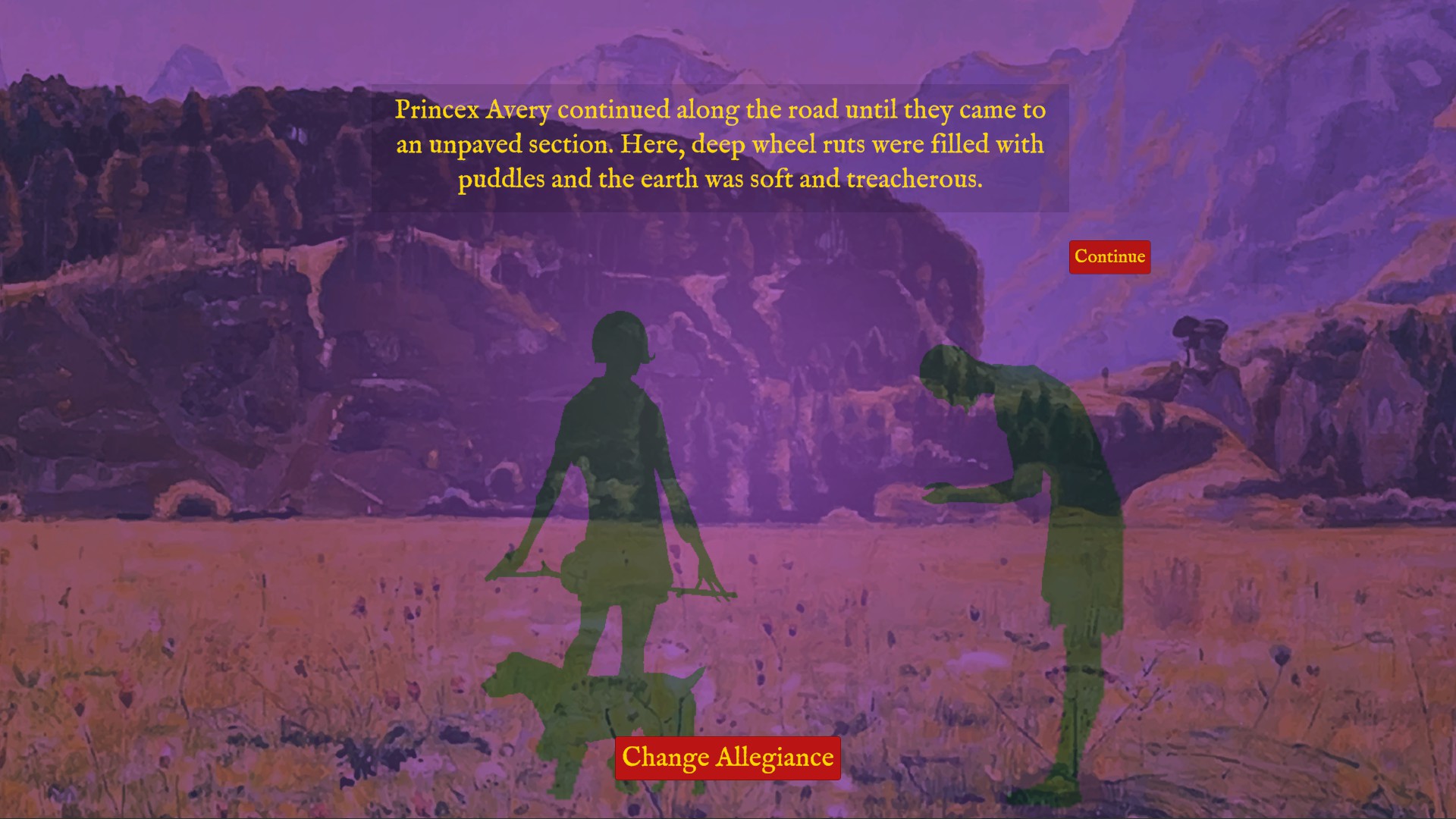
There’s not a lot here, and although it’s sweet thanks to the princex being so positive yet naive, ultimately it boils down to being a bit of a pro monarchy tale that’s over in less than ten minutes. At least that’s how it came across to me. Maybe the princex is the titular fool as they seem to learn little other than how wonderful their future station is.
The Sun – The Sun
The next game was rather sweet, with you playing as the titular sun to get rid of the bad vibes, which appear as purple clouds, from people around the islands. This plays something like a twin stick shooter with the added element of you causing bonus damage if you attack on the beat of the music. It’s simple, but a nice enough game to play.
There’s no plot here, and the game just suddenly ends when you reach the finish of the second level. The lack of player feedback to being hit, and the controls feeling too floaty to be responsive and downers, but the lovely visuals and music make this feel like a pleasant enough ten minutes to spend messing around.
The Hanged Man – Thanks, Come Again
Now this one is really interesting. In Thanks, Come Again, you play a shopkeeper who is determined to fulfil every customer’s request, regardless of what they have in stock. You’ll begin each day with a number of esoteric objects, such as a patch of land, kinship, and void, and you’ll need to combine them in such a way as to meet their orders. This is pretty tricky, as orders include things like the glint in your grandfather’s eye. It’s tricky to get right, and frustrating at first as you wildly try combinations, getting things wrong over and over, resulting in you making a loss and having to start the day over.
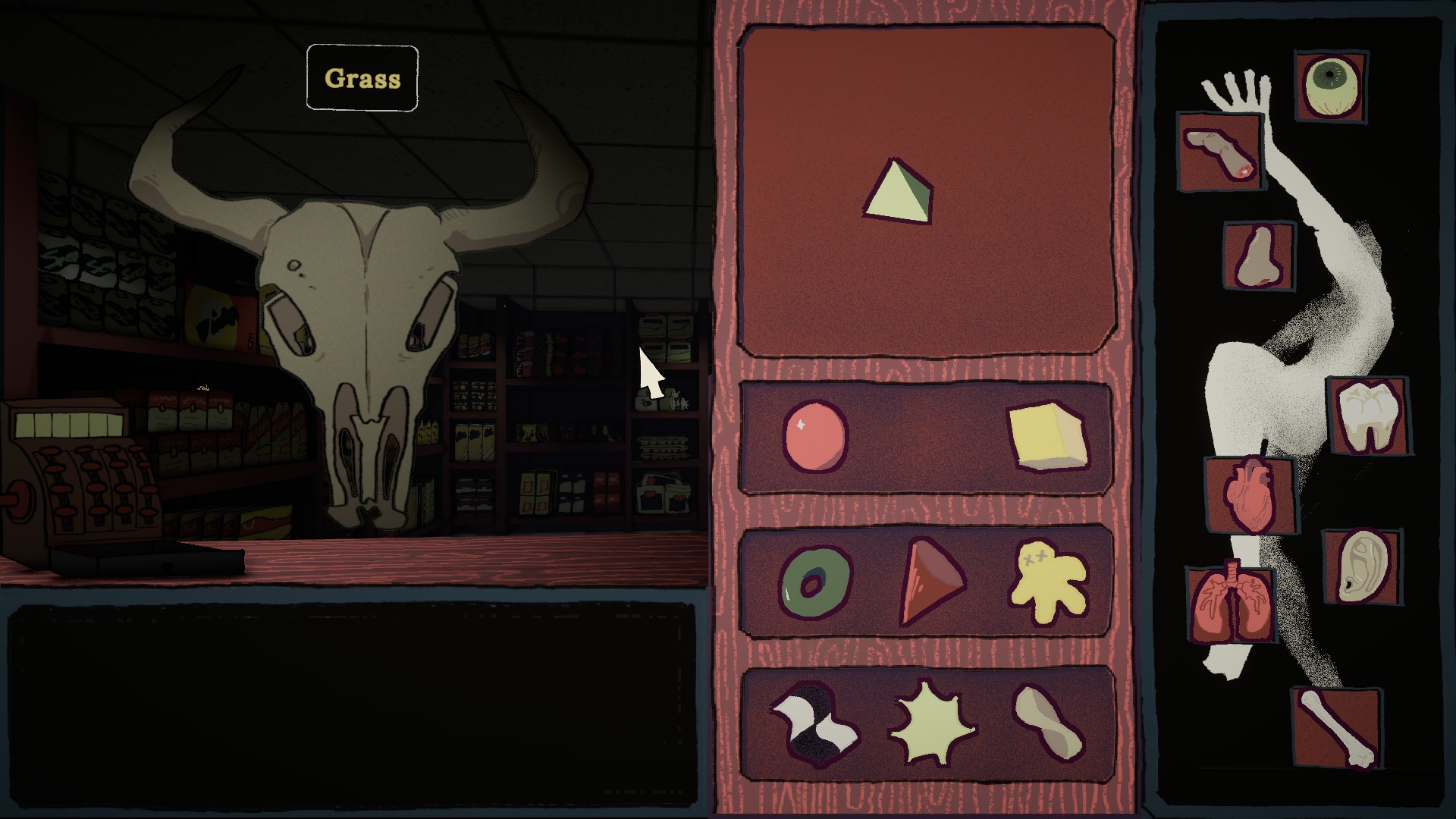
But there’s an additional mechanic, where you can offer a literal piece of yourself to the customer to guarantee you meet their needs. How long can you keep going before having to sacrifice your lungs? It’s quite unique, and the bizarre cast of characters that approach your counter are as fascinating as they are horrifying, especially with the odd sounds that some of them make when speaking. This was right up my street, and is one of the strongest offerings in the anthology.
Temperance – Temperance
Whilst I found Temperance frustrating at first, once I got the hang of its mechanics I found it quite enjoyable over the fifteen minute runtime. You are an alchemist who has inherited the family shop and must make potions for the community. People will come in with ingredients and a request and you need to put those ingredients into a cauldron so that a metre fills to a given point. Different ingredients have different effects, and at first you don’t know what does what, leading to that initial frustration.
Once I knew what did what though, I started having a bit more fun, as there are plenty of ways to complete a request along with a nice enough story about self acceptance and community. There were a few plot threads with customers that weren’t really allowed to go anywhere which is a pity, but with a nice art style and some charming sound and music, Temperance is a nice addition to this set.
Strength – Hypeman
Hypeman reminded me of a super simplistic version of the amazing One Finger Death Punch. Emails approach you from the left and right, and you need to click the left or right mouse button to punch them away. Occasionally you need to reply to one of them by clicking quickly. If you miss an email you lose a heart, and once you run out it’s game over. That’s all there is to this one.

It’s very basic and lacks the energy of the game I was immediately reminded of, but it’s nice enough to play for a few minutes. It’s unlikely to hold your attention longer than that though. I liked the artwork well enough, and if you look at the emails you get to reply to, some of them might elicit a little chuckle. I probably won’t return to this one.
Wheel of Fortune – Cast Fortune
At its heart, Cast Fortune is a fishing game. You play as a pumpkin that has been brought to life as a result of a hex and you need to catch fish for a local witch to use in her potions. There’s a bit of a theme for potions in Cartomancy Anthology apparently. Catch the appropriate fish and you’ll advance the story. You’ll spend most of your time standing on a pier, casting your line and then doing a little reaction based minigame to determine the rarity of your catch. Sometimes you catch fish, sometimes you catch inanimate objects, but you’ll always have the option to use your catch as a lure, as well as returning it to the witch.
Depending on the time of day and different weather conditions, you’ll be able to catch different things, meaning you’ll probably want to pay attention to the hints you’re given in your log. Honestly, fishing games aren’t really my thing, but this one is nice enough, and the story is told in quite a fun way, with playful, self-aware dialogue that luckily doesn’t stray into being cringe inducing. I liked the art style too, and the way your pumpkin moved around was wonderfully silly. Not a game for me, but there’s enough charm there to make it worth a look.
The Empress – Castle of Glas
This was a really solid puzzle game, in which you play as a young girl named Glas who is trapped in a mysterious greenhouse. You’ll need to grow and remove plants to find broken parts of windows to move on. Each stage is an isometric puzzle where Glas can only move in a straight line. By growing sunflowers and ivy you can reach higher points and climb across gaps, but those pieces of glass are heavy, meaning you can’t climb whilst carrying it. You’ll need to grow the plants in the correct order to reach the goal of each level.
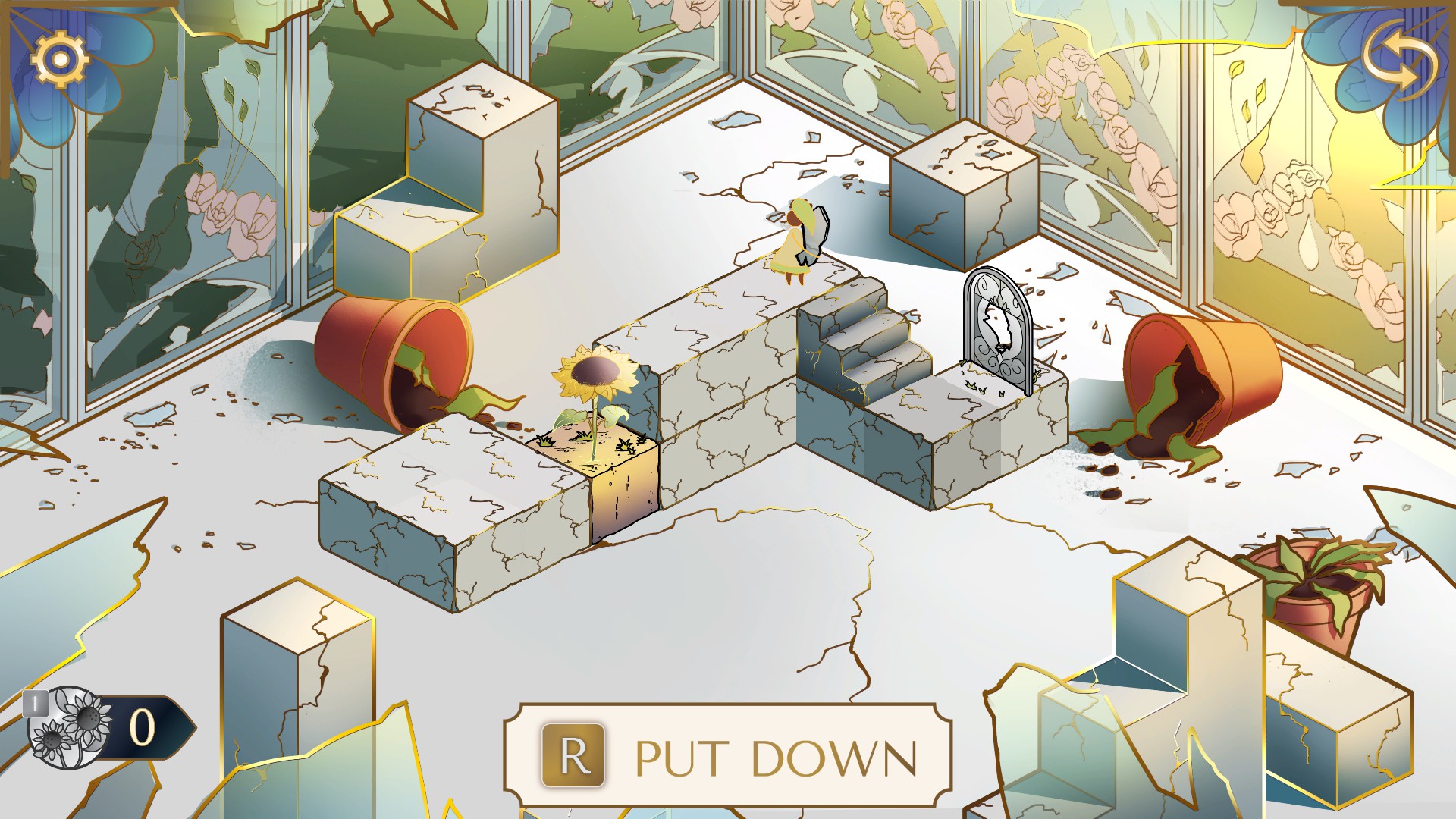
This led to some devious puzzles as you try to piece together the correct order of operations, and it was genuinely satisfying to solve some of the later ones. Restarting was instantaneous as well, meaning mistakes don’t set you back too far. The lovely minimalist art and music help make this a pleasant experience, and there’s even some solid voice acting too. A strong addition to the set.
The Hermit – The Hermit
The Hermit is a meditation on life in which you play as an old lady going through photos of various trips she made to a nearby mountain throughout various points in her life. Each photo has a door to travel to the next one and various interactive points for characters and environmental features. It’s very simple but quite pleasant thanks to some basic but effective art and some lovely ambient sound.
There are a couple of light puzzle elements where you need to find keys to progress, but they’re very simple to find. I liked that there was more than one path to the summit, meaning you could find alternative pictures on the way back down. I don’t feel the commentary on how life could be spent and how you may look back on it in old age hit all that well, as the photos aren’t in chronological order, but I’m happy enough to have played it.
The Tower – The Tower
Up next is a bleak kinetic novel — that’s a visual novel with no choice element — about a repair worker in a giant clocktower. You read the story of how they begin by seeing this as a repair job, but are gradually ground down as they wake, work, and sleep in the labyrinthine tower, without ever really feeling as though they have any purpose. Unsurprisingly, this feels like a metaphor for everyday working people being part of a machine that slowly wears them down until they give up, whilst people in power try to keep them down. Quite a relevant tale in today’s society.
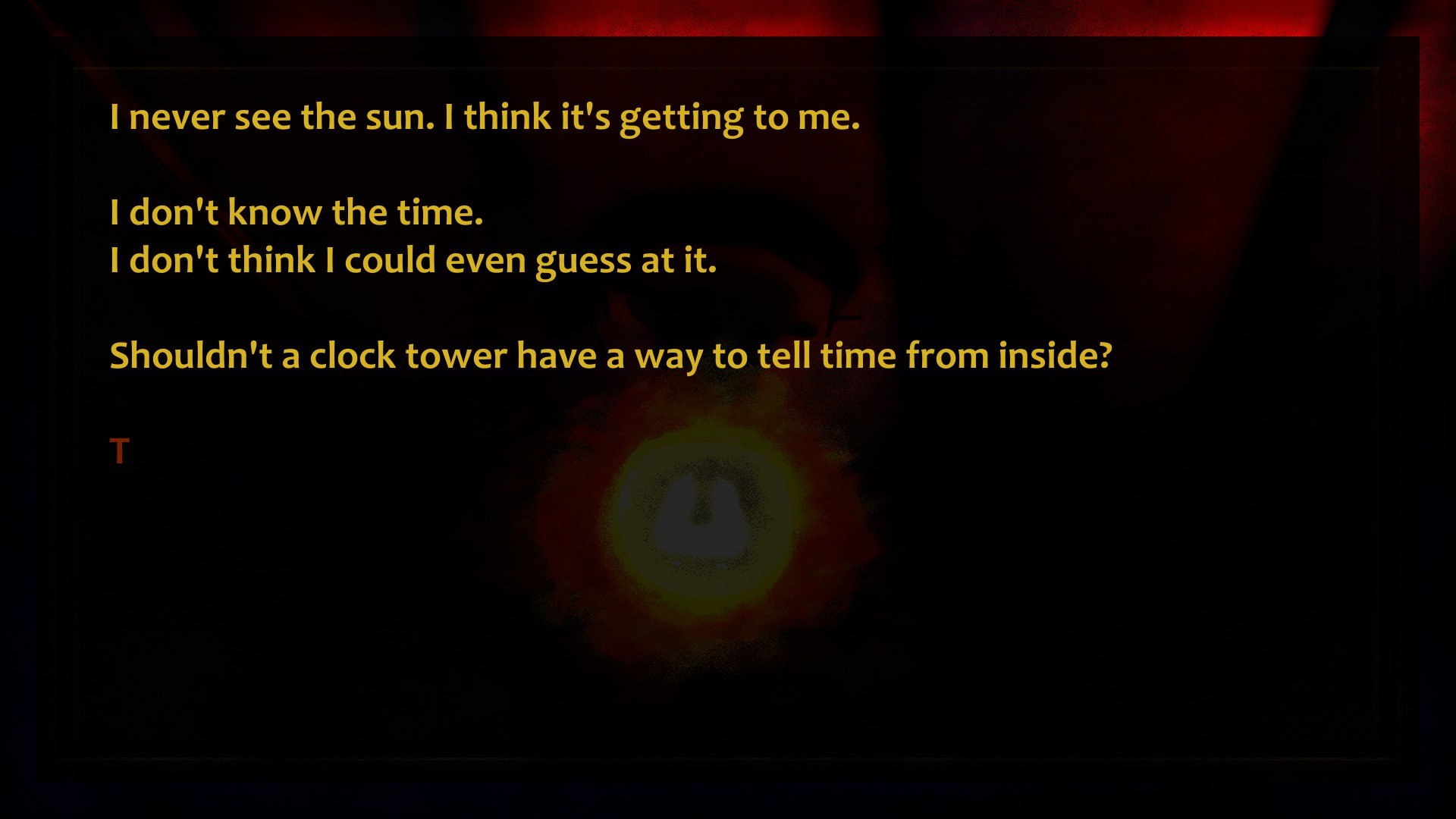
There isn’t much to say in terms of the visuals, as there are only a handful of backgrounds to the text, but they did remind me somewhat of Silent Hill, with rusted metal and broken pipes being the centre of most images. There’s little in the way of sound sadly, bar the irritating clacking of the text appearing on the screen. A missed opportunity here, as some ambient sound could have really developed some atmosphere. Not bad though, and an interesting story to experience for the five-or-so minutes it lasts.
The Devil – The Devil
And finally, a very brief kinetic novel about a child who has only ever lived in the forest. One day they see something in a field, and against their judgement, they set out into the world, facing confusion and temptation. And that’s pretty much it. This is over in under five minutes with very little actually happening.
There’s not much to say about the visuals or sound, as you only have a single screen with a few simple images on them. There’s a nice feature that has eyes appear on whichever panel your mouse pointer hovers over. Something of a disappointing final offering really.
And that’s it! 22 games that are very much a mixed bag. The tarot theme comes across with each game theming itself loosely around the title of the cards, but the variety of game styles on offer is genuinely impressive, even though a few of them were disappointing when compared to others. There’s certainly a lot on offer here for under £20, and there are some interesting meditations on the challenges of everyday life alongside more whimsical views on existence. This certainly isn’t for everyone, but it is worth a look as there are some talented developers on show here.
Cartomancy Anthology is available now on Steam.
Comments are closed.